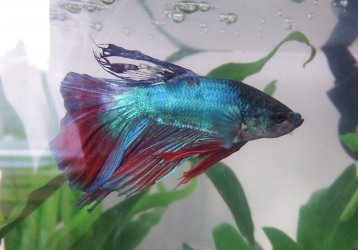DjangosMum
New Member
- Joined
- Oct 12, 2017
- Messages
- 1
- Reaction score
- 0
I don’t know exactly what is wrong or how to treat it. Need advice urgently. Any help is much appreciated.
Housing:
How many gallons is your tank? 5.3 (24 litres)
Does it have a filter? No
Does it have a heater? Yes
What temperature is your tank? 79
Does your tank have an air stone or other type of aeration? No
Does your Betta have tank mates? No
Food:
(He's not ate since I got him, but King British/ Love Fish pellets)
Maintenance:
(I've only had him 3 days so I've not changed the water yet)
What brand of conditioner? Love Fish Tap Safe
Water Parameters:
Ammonia: 0
Nitrite: unknown
Nitrate: unknown
pH: 6.5
Hardness (GH): unknown
Alkalinity (KH): unknown
Symptoms and Treatment:
When did you first notice the symptoms? 24 hours ago. (Yesterday I noticed his dorsal fin looked like it had been torn in half, but my parents thought he always looked like that and told me to just keep an eye on it)
How has your Betta’s appearance changed? His dorsal fin has nearly disappeared, the colours have started to fade at the top of his tail, the base of the dorsal fin is turning white, and he has a small white/transparent lump on his chin. (This all happened in less than 12 hours.)
How has your Betta’s behavior changed? Very inactive yesterday, but quite active today.
Is your Betta still eating? He hasn't eaten since I bought him 3 days ago.
Have you started treating your Betta? No
Does your Betta have any history of being ill? Unsure (only bought him 3 days ago).
How long have you owned your Betta? 3 days.
Was he or she ill or suffering some sort of damage when purchased? Possibly. The back of his dorsal fin looked a bit different to the rest of his fins but the guy at the pet shop said he was a crowntail so I assumed that’s just how his fin was. (I originally thought he was a halfmoon but I’m not very familiar with bettas so thought he might be a cross between halfmoon and crowntail). Now I’m guessing that it was actually fin rot on his dorsal fin.
Housing:
How many gallons is your tank? 5.3 (24 litres)
Does it have a filter? No
Does it have a heater? Yes
What temperature is your tank? 79
Does your tank have an air stone or other type of aeration? No
Does your Betta have tank mates? No
Food:
(He's not ate since I got him, but King British/ Love Fish pellets)
Maintenance:
(I've only had him 3 days so I've not changed the water yet)
What brand of conditioner? Love Fish Tap Safe
Water Parameters:
Ammonia: 0
Nitrite: unknown
Nitrate: unknown
pH: 6.5
Hardness (GH): unknown
Alkalinity (KH): unknown
Symptoms and Treatment:
When did you first notice the symptoms? 24 hours ago. (Yesterday I noticed his dorsal fin looked like it had been torn in half, but my parents thought he always looked like that and told me to just keep an eye on it)
How has your Betta’s appearance changed? His dorsal fin has nearly disappeared, the colours have started to fade at the top of his tail, the base of the dorsal fin is turning white, and he has a small white/transparent lump on his chin. (This all happened in less than 12 hours.)
How has your Betta’s behavior changed? Very inactive yesterday, but quite active today.
Is your Betta still eating? He hasn't eaten since I bought him 3 days ago.
Have you started treating your Betta? No
Does your Betta have any history of being ill? Unsure (only bought him 3 days ago).
How long have you owned your Betta? 3 days.
Was he or she ill or suffering some sort of damage when purchased? Possibly. The back of his dorsal fin looked a bit different to the rest of his fins but the guy at the pet shop said he was a crowntail so I assumed that’s just how his fin was. (I originally thought he was a halfmoon but I’m not very familiar with bettas so thought he might be a cross between halfmoon and crowntail). Now I’m guessing that it was actually fin rot on his dorsal fin.



